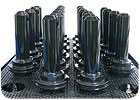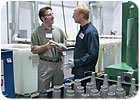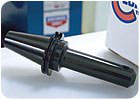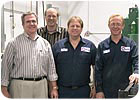Better Blackening

The finish achieved with the low-temperature, two-stage oxidation system is equivalent to hot oxide.
Command Tooling Systems, based in Ramsey, MN, manufactures tooling solutions such as holding and boring systems and accessories for precision machining operations. More than a third of the company's toolholders require black oxide finishing, and outsourcing this function added three days to its manufacturing time.
Command had considered adding its own in-house black oxide finishing system in the past, but a growing preference for shiny shank toolholders, along with other factors, caused a drop in blackening needs up until a few years ago. With the company's toolholder markets growing rapidly and productivity increasingly important to its customers, quick delivery became crucial. By late 2005, reducing the blackening turnaround time had become essential to improving Command's manufacturing efficiencies and inventory management.
"Command is expanding its markets beyond the borders of North America," said Robert Rubenstahl, president and chief operating officer. "We are dedicated to continuing the formula that has made Command the premier toolholder manufacturer in this country - quality, delivery and service."
The company began looking for a new black oxide finishing system that would help it achieve these goals.

On-site service was a major factor in the decision-making process. Jesse Vouk, Birchwood Casey's area sales manager, and Perry Ell, Command's system operator, review system performance regularly to ensure that quality objectives are met.
A Low-Temperature Solution
One of the systems Command evaluated was a two-stage oxidation process called TRU TEMP, developed by Birchwood Casey, Eden Prairie, MN. The process operates at temperatures 100 degrees lower than ordinary black oxide and provides a protective finish with a satin black appearance equal to or better than that of regular black oxide. The system contains no heavy metals, carcinogens or other materials regulated by the U.S. Environmental Protection Agency (EPA), and the rinse water effluent from the process line is generally sewerable after a simple pH adjustment."We are committed to a continual improvement program for all of our manufacturing processes," said Tim Gerbozy, Command's manufacturing manager. "When Birchwood Casey presented its new non-polluting TRU TEMP process, we found a way to accomplish a number of manufacturing improvements. Our first was the quality of our toolholders."
As Command expanded globally, the company needed the best corrosion protection as well as the best looking black finish available. Command has had a long and satisfactory experience with traditional hot oxide from outside vendors and wasn't comfortable dealing with toxic chemicals in-house. The low-temperature, two-stage oxidation process appeared to be the ideal solution.
Most of Command's BT and V-flange toolholders that require blackening are made of 8620 alloy steel. With conventional hot oxides, the oxide bath is viscous and difficult to rinse off. Blind holes and recessed areas often form white salt blooms, which destroy the value of the finished part. Because the two-stage oxidation solution is much milder and cooler, it rinses freely and forms an attractive, uniform black finish, even in recessed areas. The finish is a satin black magnetite just 0.5 micron thick (20 millionths of an inch), with no effect on part dimension or material hardness. The finish has been proven to withstand up to 100-200 hours of neutral salt spray (ASTM B 117) or several hundred hours of humidity (ASTM D 1748).

The low-temperature, two-stage oxidation system provides a deep black uniform appearance and corrosion protection at a lower cost per part, and the finish is achieved in 34 minutes compared to three days when sending parts outside for hot oxide.
The system uses seven 100-gal capacity tanks (24 x 40 x 28 in. deep), with an overall line footprint of 4 x 22 ft. The finishing line is on one side of the room, with the company's Abrasive Blast Systems bead blaster opposite. Two ¼-ton Harrington hoists run on an oval track above both the tank and bead blaster setup for fast and easy movement of toolholder/components through both systems.
To facilitate toolholder processing, Command designed custom racks with changeable inserts that can simultaneously accommodate anywhere from 39 to 137 toolholders of various shank sizes. The toolholders first travel through the bead blaster to remove heat treat scale and are then loaded onto the racks and hoisted through the black oxide process line. Once blackened, the toolholders are returned to production racks as they travel back into the main shop for finish machining. This scenario keeps product handling to an absolute minimum.
Positioning the finishing line with the adjacent bead blasting system allows one person to operate both. While processing time for the tank line and bead blaster is fast, sufficient intervals occur to allow one operator to move racks of toolholders on wheeled carts into the room and through each of the various finishing stations with maximum efficiency. With this setup, every square foot of space is used judiciously, minimizing both part moves and part travel. The toolholder carrier baskets, for example, hold up to 500 lb per load, and a single load can hold up to 100 smaller retention knobs. The power hoist allows the operator to raise, lower and move full loads quickly with minimal effort. When completely loaded, the carrier baskets fully use the entire surface processing area within the tanks.
Processing of parts through the series of tanks is efficient using the hoist system. One batch of parts can be cycling in a tank while a new batch is being queued, moved and immersed in another tank. In this way, two carrier baskets can be in process at the same time to maximize the speed and output of the system.

Command's Tooling System team performed the evaluation process and implemented the new finishing system. From left: Robert Rubenstahl, president and chief operating officer; Jeff Allen, director of operations; Tim Gerbozy, manufacturing manager; and Perry Ell, system operator.
System Advantages
The low-temperature, two-stage oxidation process is safe and easy to use because the solutions are odorless, non-splattering and of low concentration. The process is designed for long bath life without the need for routine dumping. Solution monitoring and control is achieved by using a color change test that indicates proper concentration level. Because the process contains no EPA-regulated chemicals, there is no need for waste treatment equipment in Command's new installation - just pH adjustment prior to disposal. For this reason, the initial capital investment was only half that of other blackening processes Command evaluated.Gerbozy's staff quickly learned how to get the most out of the system. The company developed written procedures documenting bath times, finish quality expectations, best racking solutions for various shaped parts, testing solution concentrations and basic system operations to help bring new operators up to speed and share knowledge across three shifts of operators. Access to this knowledge frees up supervisor time and instills a level of confidence in the operator for taking on additional tasks, such as bead blasting and a small amount of maintenance to the system, so that both the blasting and finishing systems operate at maximum efficiency at all times.
Gerbozy calculates that the system currently blackens 400 toolholders and an equivalent number of retention knobs in an eight-hour shift, with available capacity to triple that output. Because the maximum number of toolholders is finished per load and moves through the system quickly, Gerbozy estimates that finish costs are much lower compared to sending them outside for finishing. "The real savings is eliminating the three-day turnaround time," he said. "With this system, I maintain control of what we're making and its costs. If things are outsourced, I lose control over the quality and delivery."
Command's operators like using the new blackening setup. There's no guesswork involved or complicated formulas to follow. The mild blackening solution operates at a moderate temperature that is well below the boiling point, so the severe splattering and boilover hazards of ordinary black oxides are not present. Additionally, with Command's part container baskets, the blackening process takes 34 minutes compared to twice that for ordinary hot oxides.
"Our customers rely on fast toolholder turnaround time. Bringing the blackening process in-house with TRU TEMP has been very beneficial in many areas, including deliveries," said Rubenstahl.
"We were comfortable knowing that we had a supplier with experience in designing the right system and being available on-site for follow up service to ensure everything operates properly. Our customers expect the best from us, and the TRU TEMP system lets us offer high-quality blackened toolholder finishes," added Gerbozy.
Looking for a reprint of this article?
From high-res PDFs to custom plaques, order your copy today!



